Shears vs. Scissors: How Can You Tell One From The Other?
I must say:
In my experience as a barber, I’ve noticed that most people always use the terms scissors and shears to mean the same thing.
But are they similar?
No!
There are so many things that set these two tools apart. And that’s exactly what this post is all about.
Now:
In this article, I’ll go over several things that will help you understand the difference between scissors and shears; including:
- The main difference between the two
- The various types available
- How to use each
- Things you need to consider when shopping for these tools
- As well as a few Frequently Asked Questions
Ready?
If so, let’s dive right in!
What Is The Main Difference Between Shears And Scissors?
Get this:
The main characteristics that differentiate shears from scissors is their size and usage.
Basically:
Shears come with long blades; usually ranging from 5 to 7 inches in length.
What’s more?
You’ll notice one major design difference between the two; i.e. shears have one small finger rest and a bigger one.
The small one accommodates the thumb and the larger one can accommodate up to four fingers; depending on what you are comfortable with.
Also:
Due to their large size, shears are often more efficient for heavy cutting.
On the other hand:
Scissors have shorter blades; i.e. usually less than 6 inches in length. Plus, their finger holes are usually equal in size and symmetrical.
If you want to make quick, easy, light, and precise trims, a pair of scissors will be your best option.
Moving on…
How to Use Each of Them
Now:
If you’ve been wondering how each of these tools fair in terms of usage, here’s what you need to know…
How to Use Scissors for A Haircut
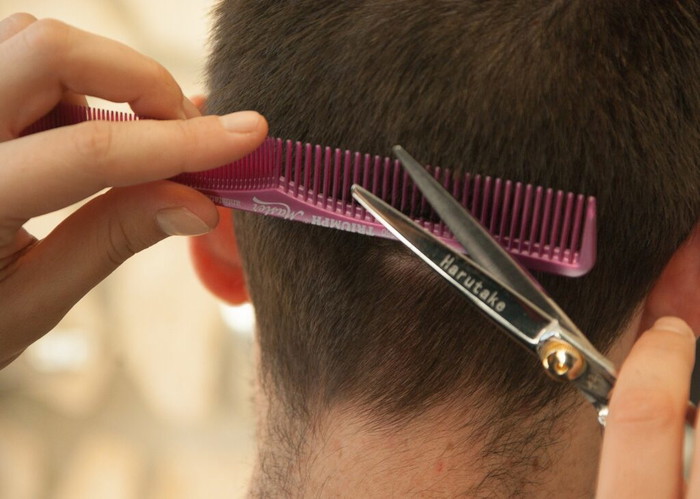
Note:
Cutting your hair with a pair of scissors is not as easy as it seems. But it’s also not rocket science either.
You just need to know what to do, how, and when.
For example, you can do this:
- First, ensure your hair is clean.
- Then start with small, light cuts to avoid trimming more than you want to.
- As you begin to cut your hair, divide it into sections and pull the hair straight up with your fingers. This exposes the full length of the hair and allows you to know how much you want to take out.
Remember:
Your scissors need to be parallel to the hair peeking through the fingers so that you can snip them and get an even cut. Plus, having a steady hand is paramount.
If you don’t trust your hands that much, it’s advisable to go to your local barbershop for the trim.
And just like that, you’re done.
How to Use Shears for A Haircut
Get this:
With shears, the process used is much similar to cutting with scissors.
The only difference is that these tools, being relatively larger, will enable you to cut out huge volumes of hair with ease.
Plus:
The fact that you can insert more than one finger on the bigger hole means that you’ll have better support and power when using this tool.
What Are The Most Common Types Available?
Obviously:
There are different types of shears and scissors available.
Hence:
It’s always wise to learn as much as possible about them so as to find the most ideal tool for your styling needs.
Right?
And so…
Let’s take a look at each type.
Common Types of Scissors
1. Swivel Scissors
It’s a fact:
Cutting hair for a long time can lead to physical strain; mostly, on your wrist, fingers, and sometimes your shoulders.
However:
Swivel scissors are some of the most comfortable haircutting tools available.
Their special design increases flexibility while reducing the discomfort and pain that comes with cutting hair over long periods.
What’s more?
These scissors have a thumb-rotating ring (the swivel).
Why is this important?
Well:
The rotating ring ensures your elbows and wrists do not strain and allows you to cut at different angles with ease.
That said:
Swivel Scissors are suitable for novice barbers or those who cut hair often, to avoid motion injury in the long run.
2. Thinning Scissors
Now:
As the name suggests, thinning scissors texturize thick hair by reducing the bulk or removing the extra strands. They have two blades, one with teeth/tines, and the other, a smooth one.
Note:
The blade with tines cuts hair in even sections, reducing the bulk and softening the ends on the strands.
And that’s why thinning scissors come in handy during a haircut finish; i.e. can help to spruce up the shape or structure of a haircut.
Simply put:
You can use thinning scissors to:
- Blend and add texture to the hair
- Remove excess hair; i.e. turn thick hair into something thinner and lighter
- Add finishing touches to a haircut
Anyway:
You should note that the teeth on these cutting tools determine their overall performance. Some tines are often designed to be close together, while others are far apart.
And:
A blade with small teeth is usually ideal for blending hair and softening blunt ends. Basically, the smaller the teeth, the more blended and even the hair will be.
Also, blades with wider teeth (between 7 and 15 tines) work great when it comes to removing extra hair weight.
Pro Tip:
When using thinning scissors with wide teeth, be careful as the cuts are often aggressive and can take out more hair than intended.
3. Long-Bladed Scissors
You might have noticed that:
Some haircutting techniques use both scissors and a comb; it’s usually referred to as the scissor over comb cutting method.
Anyway:
For such techniques, a pair of scissors that covers a bigger surface is always the best fit. This is because they are meant to cut all the required hair in one snip.
And:
That’s why Long-Bladed scissors are ideal for such applications.
These tools always come in handy for haircuts that need straight cutting lines or for blunt cutting. Their 6 to 7 inch long blades ensure an even cutting line.
4. Short-Bladed Scissors
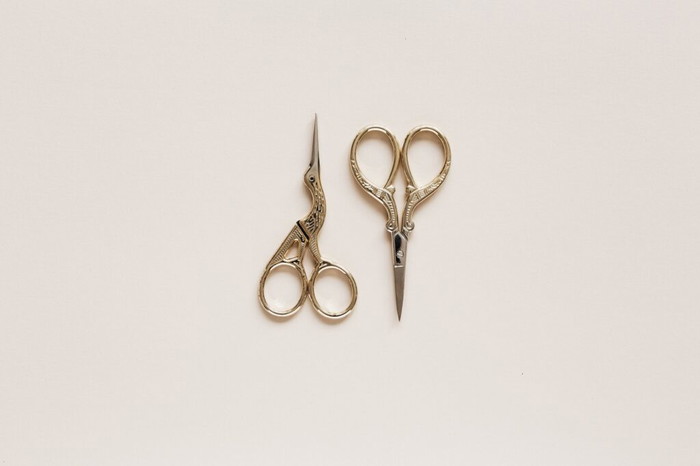
Get this:
Length is an important factor when choosing haircutting tools. And much like the long-bladed ones, you can also find short-bladed scissors.
What’s so special about these tools?
Well:
Their blades range from 4 to 5.5 inches. They are most suitable for people with smaller hands as they are light and easier to use.
Moreover:
Their miniature design greatly reduces hand fatigue. And this makes short-bladed scissors the perfect pair for haircutting techniques such as slicing.
5. Left-Handed Scissors
Fun fact:
Left-handed people account for approximately 10% of the total world population. And that’s why it’s prudent to have tools specially designed for them.
Obviously:
If you are left-handed, using right-handed scissors can be a struggle; it’s not only uncomfortable but also often leads to messy cuts.
But:
Things get better and easier with left-handed scissors.
Basically, these cutting tools have their blades and finger grips reversed. The top blade is on the left instead of the right, to enable you to see the cutting line.
The reverse blades also allow for efficient hand movement when working.
6. Offset Handle Scissors
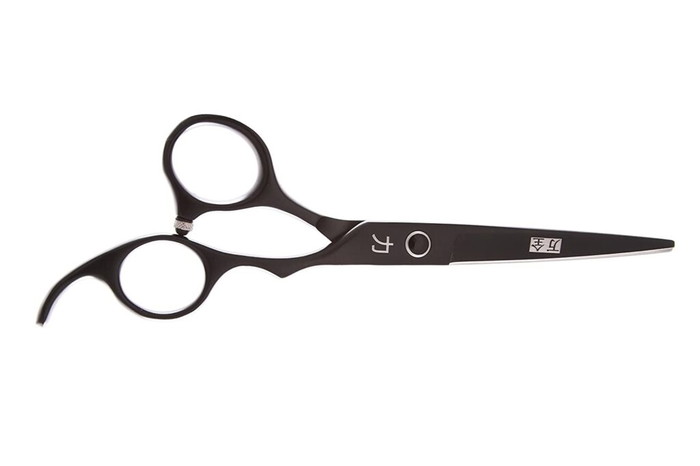
Lastly:
Offset handle scissors are popular among hairstylists and barbers because of their design.
What’s so special about them?
Well, their design features a short thumb handle coupled with a longer finger handle.
This intuitive design creates an open-hand position by reducing the distance between the opening and closing of the blades.
What’s more?
You can rest four fingers on one handle while the thumb is on the other. And to maximize comfort, your elbow and arm should be in a lower position during use.
Bottom line:
These scissors help to reduce stress and strain on your hands, arm, and shoulder. They also allow you to cut hair faster because you can angle your hand easily.
Moving on…
Common Types of Shears
1. Texturizing Shears
Now:
Have you ever gotten a haircut that wasn’t pleasant to the eyes? Your best solution would have been to fix your haircut using texturizing shears.
Why?
Well, the primary function of these cutting tools is to get rid of a considerable amount of hair.
Note:
They have approximately 12 to 16 wide-spaced tines; these teeth play a special role in achieving textured haircuts.
Moreover:
You can use them to add some volume to your hair.
How?
Texturizing Shears achieve this by creating a layered structure; where the shorter hairs are kept underneath while longer ones stay at the top.
You should also note that:
Thinning scissors are often confused with texturizing shears.
The difference between them is in their functions; texturizing shears add volume to your hair while thinning scissors remove excess hair.
Get it?
Pro Tip:
Texturizing shears are ideal for all hair types and can create both simple and dramatic hairstyles.
2. Haircutting/Styling Shears
Look:
Hair-cutting shears are basic tools whose specific function is to cut hair. They are also known as barber or hairdressing shears.
Design-wise:
They are larger than scissors and have a finger rest or tang, attached to one of the finger rings.
Plus:
These shears offer extra control when in use and reduce the stress applied on the thumbs when cutting hair
Sounds, good?
3. Razor Shears
Lastly:
You’ve got the Razor Shears.
The function of these tools is to texturize hair, but not in the same way as texturizing shears. They’re designed in such a way that the base has a finger rest while the top has a blade.
Now:
Their texturing creates jagged lines and a haircut that looks more natural. For this reason, only use them at the end of a haircut.
What’s more?
They do not make cutting motions.
Generally:
The stylist holds the hair with one hand, while the other hand uses the razor.
That said:
What should you look for when shopping for these cutting tools?
Read on to find out…
Tips for Buying Hair Cutting Scissors or Shears
So:
There are so many different types of cutting tools out there.
Therefore, finding the one that suits your personal requirements can be confusing.
Luckily:
In this section, I’ll answer some of the questions you may have about how to choose the right pair of scissors/shears in 2021.
Here are a few considerations you need to make:
a. Consider Your Haircut Style
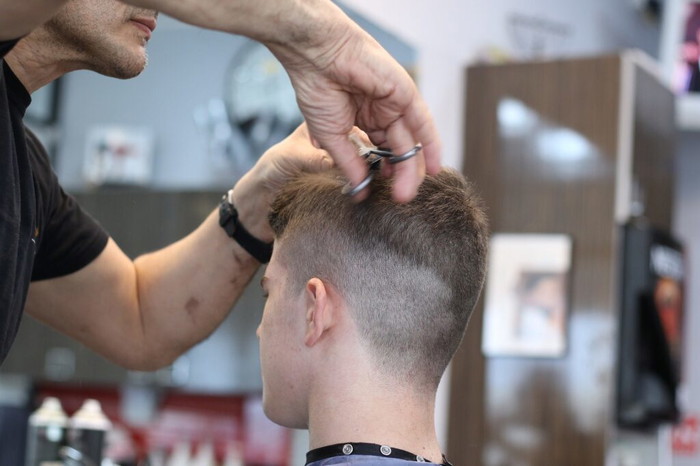
First:
You need to understand that the type of hairstyle you are looking for will determine which kind of scissors/shears you need.
Right?
That’s because the quality of your haircut depends on your tools of choice.
Note:
Scissors with blunt blades and poor designs will most likely result in sub-standard hairstyles and can even damage your hair.
Therefore, to be on the safe side, you should make sure that the tools you buy have been designed to work on your intended haircut.
b. Ensure You Get the Right Type of Blades
Yes!
When choosing hair-cutting scissors/shears, the type of blade is an important factor to consider.
Generally:
Every blade performs a specific function. Thus, you need to ensure you know the kind of blade you are looking for.
What are these types?
Well:
You can get…
1. Convex Blades

These blades, also known as the Japanese-style blade, have a slight curve on the edge, forming an angle.
More so:
Their edges are very sharp and require a lot of caution and care during use. This type of blade is the best for advanced cuts and finishing haircuts.
2. Beveled Edge
Now:
Beveled edge blades are blades that are ideal for simple cutting techniques. They cannot perform functions like slide-cutting which is a bit advanced.
And:
They cut well but need more force than a convex blade. One advantage is their durability; not forgettingthe flat surface that their cutting-edge offers.
3. Semi Convex

You get the best of both the blades mentioned above.
When you combine a convex with a beveled edge blades, you end up with semi-convex blades.
So, what makes it so special?
This type of blade has a narrow beveled edge with a slight curve. Plus, it is sharper than a beveled edge blade and more durable.
Anyway:
Apart from the type of blade, their length matters too.
Get this:
A short blade enables precise cutting and is best for trims that are close to the skin and touch-ups. However, a longer blade enables efficient, fast, and bulk cutting. This makes it suitable for bob cuts, slide cutting, and thinning thick hair.
Pro tip:
When looking at the length of a blade, I recommend a length that matches your hand’s length.
c. Pay Attention to the Handles
Note that:
Haircutting shears/scissors have different handle designs, each with its benefits.
And:
Handle design is important because of the need for comfort during use.
For maximum relaxation and convenience, the handle design should match the shape of your hand and haircutting style.
Generally:
A straight handle, also known as a level handle, is the most basic handle design. The finger and thumb handles are straight, opposite each other, and of the same size.
Also:
An offset handle is a design such that the finger and thumb handles are in offset positions; i.e. the finger handle is longer while the thumb’s is shorter.
Lastly:
A Crane handle design is longer like the level handle but comes with an angled thumb position. This design reduces pressure on the wrist and enables precision in cutting.
d. Choose Quality over Price
Get this:
With the huge variety of scissors and shears in the market, prices vary.
At first thought, you may consider buying the most affordable scissors or shears you can get. But as you decide, bear in mind that cheap can be expensive in the long run.
I know:
It is often easy to choose scissors with the lowest price.
But:
The problem is that you are likely to end up with poor-quality scissors that won’t perform or last long.
Therefore, always go for quality not price.
e. Maintenance & Durability
Obviously:
You want something that will last longer and won’t be a pain to maintain.
Right?
Note that:
Some shears/scissors blades last longer than others; especially, if well maintained.
Take it from me, the best of these tools have very little maintenance needs; i.e. you can use them for long if you:
- Lightly oil them from time to time
- Clean/wipe them after every use
- Store them properly
If the tool you want to buy needs more love and care than this, then it’s not worth it.
f. Usability and Handling
It goes without saying that:
The tools you buy MUST be easy to use and handle.
Right?
The last thing you want is to spend money on something you probably won’t enjoy using.
Therefore:
Before purchasing any haircutting tools, ensure you have all the details of the product. Insist on knowing its degree of performance; watch relevant YouTube videos if you must.
Just try to learn as much as possible about the tool before adding it to your shopping cart.
With that in mind:
Here are a few FAQs that may offer more insights on this topic…
In Conclusion
Let’s face it:
Scissors and shears are tools that never miss in a hairstylist’s or barber’s kit. Lately, their use at home has grown, as DIY haircuts gain popularity.
With all this information, you are now ready to shop for a pair of haircutting scissors best suited for your hair and style.
Right?
Well, I hope you’ve found the info provided here useful. Don’t hesitate to leave a comment, question, or even contribution to the topic below.
I’d love to hear your thoughts.
Frequently Asked Questions
More from Mike Medders
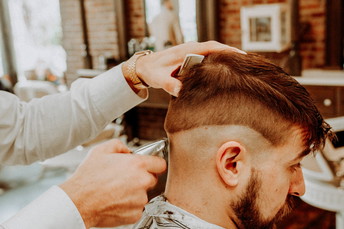
How to Talk to Barbers Like a Pro: Insights from Expert Barbers

Trust me, I've been on both sides of the chair. I can't count the number of times a client has sat down and struggled…

Slick Back Haircut

Barber Spotlight: Slick Back Haircut Transformation by Nat The slick back haircut is a timeless classic, combining…
thank you for the article


Comments